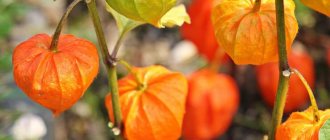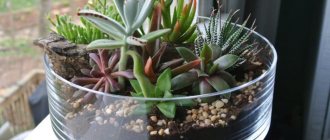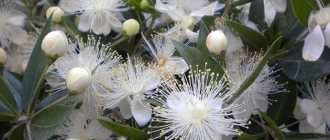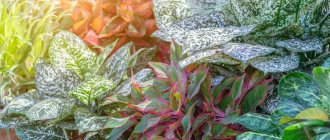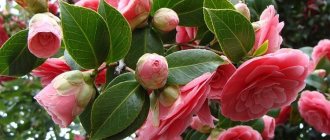Description of the flower
Ageratum (translated as “ageless”) , a tropical flower native to India and Central America. There the plant grows as a perennial, but here it is an annual, because it is not used to even slight frost.
Blooming ageratum
The flower blooms for a long time, continuously in pink, purple, blue or white. The flowers are pubescent, small, and are in inflorescences. The inflorescences come from the stem, their diameter does not exceed 5 cm. The shape varies depending on the subspecies.
The plant is bushy, spreading, with many shoots. The rhizome is developed. The stem is erect and can reach half a meter in height. The foliage is dominated by a rich green color, its shape is oval, triangular, the edge is with small jagged edges.
The foliage of the flower contains substances that irritate the mucous membranes and cause allergies.
Types and varieties
Of the 40 or 60 species of the genus Ageratum, only one is widespread in culture - Houston's ageratum. Everything else sold in seed stores is its variety. There are many of them:
Blue Mink is the most common variety. It is considered the bluest of ageratums, but in reality it is not as blue as on the seed packets. It's more of a bluish-purple color.
There are other interesting varieties, but these are found on sale almost everywhere.
Varieties Pink Ball and Clown Nine Wine are rare, but are found in gardens. Ageratum Houston Ageratum Pink Ball Ageratum Cloud Nine Vine
General recommendations for growing plants
Ageratum can be grown in open ground and on a windowsill, that is, indoors. In any case, for active growth and flowering of the plant, you must adhere to certain rules.
For a flower to grow in open ground, you need to make sure there is no frost.
For active growth, ageratum needs sunlight and warmth.
In addition, you should take seriously:
- Landing place. There should be no drafts or shadows. Even a slightly shaded area will negatively affect the behavior of the plant. The stem will rush upward, the foliage will thin out, and there will be few inflorescences. The plant will tolerate a maximum of two hours of shade per day, but no more.
- Selection of soil. The soil is preferably non-acidic, preferably light. Definitely nutritious, but in moderation. Otherwise, there will be no abundant flowering, everything will grow. It is not advisable to plant ageratum where it is damp and there are a lot of stones. In such a place the plant will hurt. It is advisable to make drainage and thoroughly loosen the soil.
- The timing. The best planting period is the middle, end of March, provided that frosts are not predicted.
Difficulties in growing and caring
When planting ageratum early, the color of the leaves may change to a lighter color due to low temperatures at night. In this case, timely hardening of seedlings with shelter during the cold night will be an effective preventive measure. Targeted hardening with removal of seedlings to the balcony is also possible. The following are used as shelter: cellophane, paper bags, cut-off bulky plastic eggplants.
If the ageratum is not watered correctly, the plant may turn black and rot. Abundant watering from above causes water droplets to be retained by the fuzzy top part of the plant. If there is insufficient ventilation, the flower will become moldy, with further negative consequences. In this situation, only the root method is a mandatory and correct condition for watering.
How does a flower reproduce?
The plant can be cultivated by seeds and cuttings. The seed method is simpler, but in this case it is important to calculate the time of sowing in open ground. Even minor frosts will lead to damage to the seed material.
indoor ageratum
Cuttings will require preparation in advance (from the fall). Before you take a cutting, you need to provide the plant with good care indoors throughout the winter.
Planting material
Seeds are collected immediately after flowering has occurred. The plant will wilt three weeks after the buds open.
The seeds are elongated, smallish, light brown in color.
After the seeds have been collected, they need to be placed in a paper bag (bag). It is important to keep them dry and cool. If we are talking about cuttings, then they are cut in spring from a plant that has overwintered in a pot. More details below.
Growing from seeds
The majority of flower growers grow this way. This process will take a little time, and most importantly, everything can be done in one season.
Preparing containers, soil, drainage
The first thing to do is find a container for sowing. It is advisable to apply fertilizer to the soil. This is a mixture of sand, peat and humus. Everything is mixed in the same quantity.
In order for excess water to come out of the soil, you need to make drainage
Drainage will also allow the root system to breathe. It is advisable to do it both for flowers that will grow indoors and for seedlings that will then need to be transplanted into open ground.
The plant is moisture-loving; watering will be done frequently, as a result of which air exchange will be disrupted. In such conditions, harmful microorganisms begin to develop, and this negatively affects both the root and the growth of the plant. Holes are made in the container, and a 2-centimeter layer of drainage (small stones, crushed stone, pebbles, expanded clay, etc.) is placed on the bottom.
Lighting
Ageratum loves long and bright light
The container with seedlings should be installed in a well-lit place. The best place is the windowsill. If there is poor sunlight entering the room, you may need to provide additional lighting.
Sowing
Sowing is done in a thin layer so that the seed material is distributed evenly. The seeds need to be placed on the surface of the soil, then crushed with the same soil composition.
First make sure that the planting material is in order (not spoiled). If the seeds were collected from a healthy plant and stored correctly, then problems should not arise.
Temperature
After sowing, the optimum temperature is maintained at 17-22 degrees Celsius. The container is covered with film material or glass.
Optimal temperature is very important for seed germination
After 10-14 days, shoots should appear.
Watering
Watering seedlings
Monitor watering all the time and ventilate the crops. Do not make a swamp, the humidity should be moderate. Irrigation frequency 2-3 times a week, in the morning.
Picking
Picking is done when the seedling already has 2 leaves. Plants are planted more spaciously. To do this, choose larger pots or containers (boxes).
Picking process
Plants should be transported carefully, always with a lump of earth, and then watered. The soil composition should be the same as the previous one.
This manipulation is carried out twice. When the time comes for repeated picking, the seedlings are placed in separate containers (the best option is plastic cups). Water the flowers in the morning.
Hardening
14 days before planting in open ground, plants need to be hardened off . If this is not done, ageratum will hurt for a long time; it will take a long time for it to take hold. Also, such flowers are more often exposed to various diseases. Some seedlings will die altogether.
For hardening, you should systematically take the seedlings outside
After placing the pickled cups in warm water. Initially, the duration of stay in such conditions is no more than half an hour, gradually the time period increases by a quarter of an hour.
If there is frost, it is strictly forbidden to remove seedlings.
Botanical description of Gauston's ageratum
The root system of Ageratum Gauston is highly branched. In places of contact with the soil on the main shoot and lateral branches, many adventitious roots are formed. The stems are numerous, strongly branched, erect, pubescent, 10-60 cm high. The leaves are triangular, rhombic or oval, serrated along the edge, serrated or crenate, rough. The lower leaves of Ageratum Gauston are opposite, petiolate; the higher up the stem, the shorter the petioles; the upper leaves are almost sessile and alternate. The flowers are small, narrow-tubular, bisexual, fragrant, collected in small baskets, reminiscent of a “puff” of powder compact, which in turn form complex corymbose inflorescences. The main decorative effect of Gauston's ageratum inflorescences is given by bilobed stigmas, which are almost twice the length of the perianth and protrude strongly above it. The perianth and stigma are equally colored.
The ovary of Ageratum Gauston is inferior. The fruit is an elongated wedge-shaped achene, pentagonal, with sharply protruding ribs, sometimes slightly curved, 2-3 mm long and up to 0.6 mm wide. At the upper end of the achene there is a white membranous pappus. The surface of the achenes is very finely longitudinally wrinkled. Color: black-brown. There are 6-7 thousand seeds in 1 gram. Seeds remain viable for 3-4 years.
Seed propagation of Ageratum Gauston, even with the most careful selection, does not produce homogeneous offspring. The varietal purity of most varieties does not exceed 80%.
Ageratum Gauston seeds set well. In central Russia, seeds ripen mainly on the main shoot and first-order shoots. In the event of a rainy autumn, some of the inflorescences rot. In the southern regions, the seed yield is much higher.
There are studies that some types of ageratum, in particular Ageratum Gauston, are dangerous for animals, as they have carcinogenic properties and cause liver disease.
Ageratum pink. © Shihmei Barger
Planting in open ground
What the seat should be like is already described above. The distance between plants of low-growing varieties is at least 10-15 cm.
Flowering should be expected in two months
If the ageratum is tall, then 25-35 cm. The seedlings do not go too deep into the ground. They are placed in the hole at the same depth as in the container. It is advisable to fill the holes with drainage to avoid stagnation of water in them.
Growing from cuttings
Thanks to cuttings, you can get a not very tall, but bushier ageratum. Also, this method is necessary if the goal is to breed hybrids, because they do not reproduce using seed material.
Harvesting cuttings
If propagation by cuttings is preferred, then you should remove the flower from the ground before frost (this is done together with a lump of earth). Place in a pot (container).
Next, it is cared for like a houseplant:
- In order for the ageratum to survive the winter period, it must be placed where there is a lot of light, no draft and the desired air temperature (19-23 degrees Celsius)
- provide moderate watering (avoid drought and waterlogging)
- apply complex mineral fertilizers
In April, cut the cuttings. Their length should not exceed 15 cm. Treat the sections with a product that accelerates growth (heteroauxin or Kornevin).
Next comes the turn of rooting. The cuttings are planted in loosened, fertilized, moistened soil. Then place it in a bright place.
Plants need warmth, so they are covered with oilcloth or glass. The temperature is maintained within 19-22 degrees Celsius.
Ageratum Houston: varieties
Ageratum Houstona is available in many attractive varieties, such as:
Blaue Donau
- blue flowers
- compact growth
- height from 15 cm to 20 cm
Blue Horizon
- blue flower color
- height up to 70 cm
- flowering period from June to September
Basso Purple
- purple flowers
- especially the early variety
- flowering period from April to September
- height up to 45 cm
Alto Delft
- color purple
- height up to 35 cm
- good for flower boxes
- flowering period from May to September
Bicolor
- rare variety
- two-color: white and blue
- height from 15 cm to 20 cm
- good for containers
Capri
- blue flowers
- height from 15 cm to 20 cm
- beautiful as a border or in a container
- flowering period from June to October
Atlantic
- ultramarine color
- growth height up to 20 cm
- compact growth
- flowering period from May to September
Blue Eyes
- dark blue flowers
- compact height up to 20 cm
- works well outdoors
- flowering period from May to October
Old Gray
- gray-blue flowers
- height up to 50 cm
- rare variety
- flowering time from June to September
All varieties of Ageratum Houston not only create a dense carpet of flowers and grow well in flower boxes and pots, but also perfectly complement each other with flowers of different colors. Large varieties serve as a creative design element when planted against a backdrop of small-flowering perennials. The Houston Ageratum is so versatile that gardeners can give free rein to their imagination and reinvent a unique planting every year.
Share this article
Flower care
Well-groomed ageratum bushes
In order for the ageratum to make its owners happy with lush flowering, it should be carefully looked after. You need to pay attention to watering, fertilizing, pruning, loosening, and weeding.
Top dressing
In order for the flower to grow actively and bloom beautifully, you need to regularly add fertilizer to the soil. This is usually done once every 14-21 days. Here it is advisable to use humic and mineral fertilizers. You can take organic matter - mullein infusion.
Complex feeding
The use of fresh manure is strictly prohibited! This will lead to negative consequences.
Many gardeners prefer complex fertilizers. Initially, feed the flower with a minimum dosage. If there is an excess, the growth of ageratum slows down. Much does not mean good.
Watering
Watering should be done systematically. It is important to ensure that the plant is not over-watered. This will lead to rotting of the rhizome.
On hot days, one abundant morning irrigation is enough.
But in any case, you need to look at the circumstances. If there is no sun, then 3-4 times a week is enough.
Trimming
To get lush and beautiful bushes, you need to periodically prune the plant. During pruning, only a few internodes remain (3-4, no more). This promotes flower growth. It is also necessary to regularly remove those inflorescences that have wilted.
Secateurs are a must-have tool for a good gardener.
If there are damaged parts of the plant, it is advisable to remove them immediately. If the cause of their deterioration is a disease, then they are burned, and the plant is immediately treated with a special preparation.
Weeding
The gardener is constantly required to weed the beds to remove weeds.
If this is neglected, the weed will take all the useful substances from the soil, and accordingly the flowers will lack them. Pests are also much more likely to appear in the grass. All this will not only slow down the growth of the plant and lead to poor flowering, but can also contribute to its death.
It is important to systematically loosen the soil. This will allow oxygen to penetrate to the root, preventing the formation of an earthen crust and various diseases.
After loosening, it will be useful to cover the soil with mulch. This will prevent rapid evaporation of moisture.
Here it can be used:
- straw;
- sawdust;
- dry leaves;
- compost;
- husk, etc.
If you listen to all the recommendations, the ageratum will bloom for a long time and actively.
What actions to take after the ageratum has faded?
Before the onset of the first cold weather, it is recommended to dig up the largest bushes and place them in separate containers. This beauty can be brought into the apartment, onto the balcony, etc.
Active flowering phase
After this, ageratum is grown as a houseplant. With the arrival of spring, the flowers can be planted in their original place.
The plant is not frost-resistant and will not survive even slight frosts. Leaving it in the ground for the winter, you can forget about it next year.
Possible complications
If left untreated, hypertension can cause brain damage.
Hypertension is the most important factor determining the risk of stroke. Compared to individuals with normal blood pressure, patients with hypertension have a 3-4 times higher risk of stroke. The cause of 80% of strokes is blockage of the lumen of the vessel, and in the remaining 20% of cases the stroke is of the nature of hemorrhage.
With arterial hypertension, damage to the blood vessels of the brain occurs with the development of arteriosclerosis (macroangiopathy). Patients with high blood pressure may experience occlusion and severe stenosis of large cerebral vessels with subsequent development of stroke. In addition, disturbances in blood flow lead to damage to small vessels of the brain, as well as their branches (microangiopathy).
If hypertension is left untreated (especially in childhood), the consequences will be so serious that it will be almost impossible to cure them. Complications include the following:
The child's development is slowed down. Attention is scattered, it is difficult for him to concentrate. Possible development of mental illness. The shape of the skull changes: the fontanel begins to protrude, the frontal bone also protrudes noticeably forward. Compression of the brain leads to convulsions, breathing problems, frequent loss of consciousness, vision decreases, sometimes to complete blindness. With prolonged hypertension, the child develops encephalopathy. At the same time, memory decreases, sleep and mental performance are disrupted. Mental disorders lead to sudden changes in mood, from stormy and active to complete apathy
The child forgets words, confuses the names of objects, and develops dementia.
Trauma and damage to the brain cause a disease called residual encephalopathy. It develops some time after brain damage. And it doesn’t matter how he was injured, mechanically or due to exposure to drugs or toxins. This disease develops quite slowly and is characterized by memory impairment, mood swings, insomnia, dizziness, weakness, and headache.
The brain, when compressed and displaced, cuts into the foramen magnum or into the notch of the tentorium cerebellum. This inevitably leads to death. Sometimes there is wedging of the uncus of the temporal lobe. In this case, the symptoms consist of an enlargement of the patient’s pupil on the side where the compression occurred. The pupil stops responding to light. As pressure increases, the reaction of the second pupil is lost, and coma or respiratory arrest occurs.
Another complication of persistent intracranial pressure is loss of vision due to optic nerve atrophy.
Caring for an indoor flower
Indoor ageratum
Ageratum can be grown not only outdoors, but also indoors. The flower needs a spacious pot with excellent drainage. In the summer, it should be taken out onto the street, balcony, veranda or terrace. If you provide the plant with all the appropriate conditions, it will bloom all winter and be pleasing to the eye.
The florist should adhere to the following recommendations:
- The pot needs to be installed on the south side of the house. The place should be well lit and warm. To monitor the temperature, you can hang a thermometer nearby.
- Watering is carried out under the rhizome. You don't want water getting on the foliage. Excess moisture is excluded. The best time for watering is morning.
- After watering, the soil is loosened. This allows air to flow to the root. Neglecting this moment can destroy the flower.
- There is no need to feed the plant often. Once every 4-6 months is enough. A complex fertilizer would be suitable. It can be purchased at any flower shop. How to use it and dilute it will be indicated on the packaging.
- If ageratum grows strongly, it should be planted in spacious containers (pots).
Based on all the above rules, we can conclude that this is an unpretentious plant (all of the above points are present in growing any flower), but a very beautiful plant.
Pests and diseases
The ageratum flower is prone to damage by various diseases and harmful insects
The following may appear:
- root rot
- gray rot
- bacterial wilt
- cucumber mosaic
Diseases do not arise only with proper care.
If we talk about harmful insects, then there are:
- whiteflies
- aphid
- spider mites
- scoops
- nematoids
For prevention, it is advisable to treat the plant with insecticides.
Let us consider in detail what to do if the plant becomes infected or is struck by this or that insect:
Root rot
Root rot
Blackleg or root rot often appears. Main symptoms of the disease:
- wilting of the plant
- drying out of foliage
- the occurrence of constrictions
- color change
- appearance of brown spots
- growth slowdown
If this happens, nothing will help. The plant will have to be removed, and the soil that is also contaminated will be removed. To prevent this disease, care should be taken to keep the soil light and avoid waterlogging.
In addition, systematic loosening is required. Thanks to these manipulations, the appearance of rot is minimized.
Gray rot
Among the most dangerous plant diseases caused by fungi of the genus Botritis is gray rot. Spores are spread by wind, also by contact (with the gardener’s hands, through tools) while caring for ageratum, on the legs of insects, by droplets of water (rain or during watering). The disease is activated when there is humidity.
Dark spots on the foliage indicate damage to the plant.
In the future, a grayish coating will appear - this is the appearance of spore-bearing mycelium. At the first signs of disease, it is necessary to immediately treat all plantings with fungicides.
It is advisable to purchase:
- Fundazol
- Topaz
- Bordeaux mixture
If the situation changes for the worse, all affected individuals should be removed. You can't leave them. It is recommended to burn immediately.
Bacterial wilt
In the southern regions, plants may also suffer from this disease. At the same time, the foliage cracks, the moisture evaporates from them, and the turgor decreases.
Yellow spots appear, they have a brown border
When cut, it is clear that the choroid plexuses have darkened. As a result, sap flow is impaired. As a result, the plant dies.
To cure a flower, you need to treat it with Coronet. It's important to start this right away. If you miss time, it is not possible to save the ageratum.
If you use wilting-resistant varieties, you don’t have to worry about infection.
Cucumber mosaic
The virus is transmitted by sucking harmful insects. After infection, white or yellow spots appear on the foliage. It is impossible to eradicate the disease as it progresses, but it can be prevented.
Cucumber mosaic
It is important to weed the beds on time, plant healthy planting material and control pests.
Aphid
The size of the insect is small.
It ranges from 0.3 to 0.8 mm. The shape depends on the type of aphid. It can be elliptical, ovoid, teardrop-shaped, etc. The color is the same as that of the plant on which it parasitizes.
To get rid of aphids, flowers are sprayed with a special solution. You can prepare it yourself.
To do this take:
- garlic cloves (200 g)
- water (1 l)
The first ingredient needs to be crushed. This is done using a grater or meat grinder. Then the resulting slurry is filled with water. The resulting solution must be infused for five days.
After the required time, the infusion is diluted with additional water. Here you should adhere to the following proportions: 300ml/10l.
Spider mite
Body in the shape of an ellipse, covered with hair
The back is convex. Larvae have six legs, adults have eight. The feet have nails, which are what they use to cling to the plant. The color of young individuals is light green, but with age it darkens and becomes brownish. They reproduce by laying eggs.
Spider mites can be removed by treating with insectoacaricides.
These drugs are in the form of:
- Agraverina
- Neorona
- Nissorana
Whitefly
Whitefly
This insect is not large in size. No more than 3 mm long. The wings are covered with a coating that is somewhat similar to flour.
You can remove it:
- Mospilan
- Tanrek
- Commander
scoop
The cutworm belongs to the Lepidoptera. In appearance it resembles a gray butterfly. This insect lays eggs on the underside of ageratum leaves. The caterpillars subsequently spoil the buds and spread over all the flowers.
scoop
You can protect your garden by timely destruction of weeds. Chemical treatment of plants would also be useful.
If pest larvae are noticed on the foliage, you need to spray the flowers:
- Tsitkor
- Decis
- Inta-Virom
- Spark
- Leptocide
Nematode
This pest feeds on plant sap, as a result of which it begins to grow more slowly, loses its appearance and dies. There are leaf, root and stem nematodes.
They are a worm no more than 2 mm long
Their shape can be oval, circle or oblong. Color – white, beige.
Signs of flower damage are as follows:
- dull color of the plant
- the appearance of brown spotting on foliage
- leaf curling
- enlargement of petioles, stem
- stunting
- poor flowering
- inflorescences quickly dry out and fall off
Drugs in the form of:
- Vidata
- Dimethoate
- Nafamosa
Both the plant itself and the soil should be treated (a solution is made that is used to water the soil at the root of the ageratum).
Brief information and cultural features
Ageratum is a subshrub or herbaceous plant of the Asteraceae family. Under natural conditions it grows in India and North and Central America as a perennial. In the climatic conditions of our country, it is cultivated exclusively as an annual.
Ageratum does not tolerate frost. Sub-zero temperatures lead to the death of the plant.
The flower acquired its name for its long, continuous flowering. Gardeners affectionately call it longflower, and its Latin name Ageratum comes from the Greek ageratos, which means ageless.
Grown as an annual plant, it begins to bloom as soon as spring frosts recede, and continues to delight with blooming buds until the onset of autumn cold weather. In the northern regions, the flower is grown as seedlings and then planted on the site. In Russia, the most actively and widely used ageratum is Houston or Mexican ageratum.
Ageratum has strong and numerous branched stems. The leaves of different varieties can vary greatly:
- shape: oval, triangular, diamond-shaped;
- according to the degree of pubescence: smooth or heavily pubescent;
- by color: from light to dark green shades;
- along the edges: with jagged or smooth edges.
The ageratum flower is a basket containing two-lobed stigmas, giving beautiful splendor and fluffiness to the inflorescence. The sizes of the baskets vary from 1 to 2 cm. The flowers are collected in rounded inflorescences, resembling pompoms, from very dense to very loose. Their color range is varied: from the commonly found blue and lilac-violet, to white, pink, red and purple. The inflorescences emit a pleasant and fairly persistent aroma.
The seeds are very small, 1 gram contains from 6000 to 7000 pieces. They can be collected immediately after the branch has finished flowering.
Among ageratums there are toxic varieties that have carcinogenic properties. These include Ageratum conyzoides and Ageratum houstonianum.
This plant enjoys well-deserved respect among landscape designers. It gets along easily and combines with other inhabitants of the garden. It can become both the center of a composition and fill existing voids. Florists liked it not only for its beauty, but also for its long-lasting freshness after cutting.
Many varieties and hybrids of ageratum have been developed.
They are divided into three subgroups according to height.
- Dwarf and low-growing, the height of which does not exceed 20 cm.
- They are medium-sized, their height ranges from 20 to 30 cm.
- Tall, reaching 50–60 cm in height.
Where is ageratum used?
The flower is beautiful and therefore is actively used for decorative purposes. Low-growing varieties fit perfectly near paths, borders, gazebos, and patios. Ageratum looks indescribable in combination with other vegetation, such as zinnias and marigolds.
Ageratum in a flower arrangement
Tall subspecies will be a worthy decoration for flower beds and flowerpots. These flowers are also used as cutting material for bouquets. The aroma of flowers is intoxicating and loved by many.
Also, the medicinal properties of the flower were mentioned above. Ageratum Huston has the following properties:
- acaricidal
- antibacterial
- wound healing
- painkillers
- antiseptic
Traditional medicine practices the use of plant juice and dry raw materials for various skin problems (scratches, lichen, vintiligo, various inflammations). For this, tinctures are prepared, after which compresses, baths, etc. are made based on them.
Before using the plant, do not forget about contraindications. It is not suitable for use by women who are pregnant, nursing mothers, or children.
In addition, do not forget about individual intolerance. It is prohibited for raw materials to come into contact with mucous membranes.
Growing and Care
Ageratum: description, planting in open ground and caring for it at home (30+ Photos & Videos) + Reviews
Ageratum Houston: use
Low and compact varieties of Ageratum Houston are popular for edging flower beds, on graves and in balcony boxes.
This ornamental plant is used to fill gaps between various perennials and as a floral carpet in an open bed with marigolds, bluebells, antirrhinum and nemophila.
Tall varieties are suitable for group planting or for background decoration. They also make good cut flowers for a vase.
When combined with marigolds, marigolds, calceolaria, verbena, coreopsis, rudbeckia and heliopsis, the blue-violet flowers show off in all their glory.


